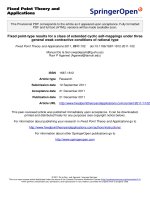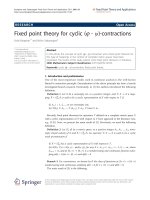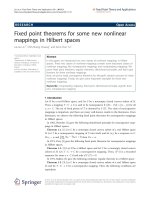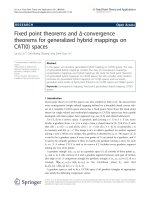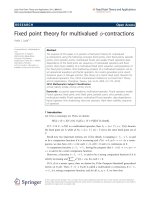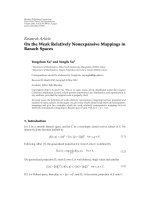Báo cáo hóa học: "FIXED POINT VARIATIONAL SOLUTIONS FOR UNIFORMLY CONTINUOUS PSEUDOCONTRACTIONS IN BANACH SPACES" ppt
Bạn đang xem bản rút gọn của tài liệu. Xem và tải ngay bản đầy đủ của tài liệu tại đây (554.16 KB, 12 trang )
FIXED POINT VARIATIONAL SOLUTIONS FOR UNIFORMLY
CONTINUOUS PSEUDOCONTRACTIONS IN BANACH SPACES
ANIEFIOK UDOMENE
Received 27 June 2005; Rev ised 21 November 2005; Accepted 28 November 2005
Let E beareflexiveBanachspacewithauniformlyG
ˆ
ateaux differentiable norm, let K
be a nonempty closed convex subset of E,andletT : K
→ K be a uniformly continuous
pseudocont raction. If f : K
→ K is any contraction map on K and if ever y nonempty
closed convex and bounded subset of K has the fixed point property for nonexpansive
self-mappings, then it is shown, under appropriate conditions on the sequences of real
numbers
{α
n
}, {μ
n
}, that the iteration process z
1
∈ K, z
n+1
= μ
n
(α
n
Tz
n
+(1−α
n
)z
n
)+
(1
−μ
n
) f (z
n
), n ∈ N, strongly converges to the fixed point of T, which is the unique
solution of some variational inequality, provided that K is bounded.
Copyright © 2006 Aniefiok Udomene. This is an open access article distributed under
the Creative Commons Attribution License, which permits unrestricted use, distribution,
and reproduction in any medium, provided the original work is properly cited.
1. Introduction
Let E be a real B anach space with dual E
∗
and K a nonempty closed convex subset of
E.LetJ : E
→ 2
E
∗
denote the normalized duality mapping defined by J(x):={f ∈ E
∗
:
x, f =x
2
, f =x, x ∈ E} where ·,· denotes the generalized duality pairing.
Following Morales [6], a mapping T with domain D(T) and range (T)inE is cal led
strongly pseudocontractive if for some constant k<1and
∀x, y ∈D(T),
(λ
−k)x − y≤
(λI −T)(x) −(λI −T)(y)
(1.1)
for all λ>k; w hile T is called a pseudocontraction if (1.1)holdsfork
= 1. The mapping T is
called Lipschitz if there exists L
≥ 0suchthatTx −Ty≤Lx − y, ∀x, y ∈D(T). The
mapping T is called nonexpansive if L
= 1andiscalleda(strict) contraction if L<1. Every
nonexpansive mapping is a pseudocontraction. The converse is not true. The example,
T(x)
= 1 −x
2/3
,0≤x ≤ 1, is a continuous pseudocontraction which is not nonexpansive.
It follows from a result of Kato [3]thatT is pseudocontra ctive if and only if there exists
j(x
− y) ∈ J(x − y)suchthatTx−Ty, j(x − y)≤x − y
2
, ∀x, y ∈ D(T).
Hindawi Publishing Corporation
Fixed Point Theory and Applications
Volume 2006, Article ID 69758, Pages 1–12
DOI 10.1155/FPTA/2006/69758
2 Uniformly continuous pseudocontractions
In [9], Schu introduced the iterative process (1.2)belowandprovedthefollowing
theorem.
Theorem 1.1 [9, Theorem 2.4, page 113]. Let K be a nonempty, closed convex, and
bounded subset of a Hilbert space H;letT : K
→ K be a Lipschitz pseudocontractive map
w ith Lipschitz constant L
≥ 0; {λ
n
}
n∈N
⊂ (0,1) with lim
n→∞
λ
n
= 1; {α
n
}
n∈N
⊂ (0,1) with
lim
n→∞
α
n
= 0 such that ({α
n
},{μ
n
}) has prope rty (A), {(1 −μ
n
)(1 −λ
n
)
−1
} is bounded,
and lim
n→∞
(1 −μ
n
)/α
n
= 0,wherek
n
:= (1 + α
2
n
(1 + L)
2
)
1/2
and μ
n
:= λ
n
/k
n
,foralln ∈N;
fix an arbitrary point w
∈ K, and define that for all n ∈ N,
z
n+1
:= μ
n+1
α
n
Tz
n
+
1 −α
n
z
n
+
1 −μ
n+1
w. (1.2)
Then
{z
n
}
n
converges strongly to the unique fixed point of T closest to w.
Here the pair of sequences (
{α
n
}
n
,{μ
n
}
n
) ⊂(0,∞) ×(0,1) is said to have property (A)
if and only if the following conditions hold.
(i)
{α
n
}
n
is decreasing;
(ii)
{μ
n
}
n
is strictly increasing;
(iii)
There exists a strictly increasing sequence {β
n
}
n
⊂ N such that
(a)
lim
n
(α
n
−α
n+β
n
)/(1 −μ
n
) = 0;
(b)
lim
n
(1 −μ
n+β
n
)(1 −μ
n
)
−1
= 1;
(c)
lim
n
β
n
(1 −μ
n
) =∞.
The first iterative process of this nature was introduced by Halpern [2]: for any fixed
w
∈ K and arbitrary z
0
∈ K,
z
n+1
= μ
n
Tz
n
+
1 −μ
n
w, n = 0,1,2, , (1.3)
where
{μ
n
} is a sequence in (0,1) with lim
n→∞
μ
n
= 1.
In [8], Moudafi proposed a viscosity approximation method of selecting a particu-
lar fixed point of a given nonexpansive mapping in Hilbert spaces, where he proved the
following theorem.
Theorem 1.2 [8, Theorem 2.2, page 48]. Let H be a Hilbert space, let T : K
→ K be a
nonexpansive self-mapping of a nonempty closed convex subset K of H,andlet f : K
→ K
be a contraction. With an initial z
0
∈ K, define the sequence {z
n
} by
z
n+1
=
1
1+
n
Tz
n
+
n
1+
n
f
z
n
. (1.4)
Supposed that lim
n→∞
n
= 0,
∞
n=1
n
=∞,andlim
n→∞
|1/
n+1
−1/
n
|=0. Then {z
n
}
converges strongly to the unique solution of the variational inequality:
find
x ∈F(T) such that
(I − f )x, x −x
≤
0, ∀x ∈F(T), (1.5)
(i.e., the unique solution of the operator Proj
F(T)
◦f ).
Xu [12]extendedTheorem 1.2 tothemoregeneraluniformly smooth Banach spaces.
If Π
K
denotes the set of all contractions on K, he proved the following theorem.
Aniefiok Udomene 3
Theorem 1.3 [12, Theorem 4.2, page 289]. Let E be a uniformly smooth Banach space, K
a closed convex subset of E,andT : K
→ K a nonexpansive mapping with F(T) =∅,and
f
∈ Π
K
. Assume that {α
n
}⊂(0,1) satisfies the following conditions:
(i) lim
n→∞
α
n
= 0;
(ii)
∞
n=0
α
n
=∞;
(iii) either lim
n→∞
α
n+1
/α
n
= 1 or
∞
n=0
|α
n+1
−α
n
| < ∞.
Then the sequence
{z
n
} generated by z
0
∈ K,
z
n+1
:= α
n
f
z
n
+
1 −α
n
Tz
n
, n = 0,1,2, , (1.6)
converges strongly to Q( f ),whereQ : Π
K
→ F(T) is defined by Q( f ):=σ −lim
t→0
x
t
,with
x
t
satisfying
x
t
= tTx
t
+(1−t) f
x
t
. (1.7)
Let K be a nonempty closed convex and bounded subset of a real reflexive Banach
space with a uniformly G
ˆ
ateaux differentiable nor m . Further to Theorems 1.2 and 1.3,
the purpose of this paper is to use the following iteration process: z
1
∈ K,
z
n+1
= μ
n
α
n
Tz
n
+
1 −α
n
z
n
+
1 −μ
n
f
z
n
, n ∈ N, (1.8)
where
{μ
n
}
n
, {α
n
}
n
are sequences in (0,1) and f : K → K is a contraction map, to approx-
imate the fixed point of a uniformly continuous pseudocontraction, which solves some
variational inequality. If the map f is a constant map then we recover the iteration process
(1.2)from(1.8).
2. Preliminaries
Let E be a real normed linear space and let S :
={x ∈ E : x=1}. E is said to have a
G
ˆ
ateaux differentiable norm and E is called smooth if the limit
lim
t→0
x + ty−x
t
(2.1)
exists for each x, y
∈ S. E is said to have a uniformly G
ˆ
ateaux differentiable norm if for
each y
∈ S the limit is attained uniformly for x ∈ S.
The modulus of smoothness of E is defined by
ρ
E
(τ):= sup
x + y+ x − y
2
−1:x=1, y=τ
, τ>0. (2.2)
E is equivalently said to b e smooth if ρ
E
(τ) > 0 ∀τ>0. Every uniformly smooth Banach
space is a reflexive Banach space with a uniformly G
ˆ
ateaux differentiable norm. An ex-
ample given in [7] illustrates that this inclusion is proper.
Let E be a linear space and let K be a subset of E.Then,foranyx
∈ K, the set I
K
(x) =
{
x + λ(z −x):z ∈ K, λ ≥1} is called the inward set of x.AmappingT : K → E is said to
satisfy the inward condition if Tx
∈ I
K
(x)foreachx ∈ K, and is said to satisfy the weakly
inward condition if Tx
∈ cl[I
K
(x)], the closure of I
K
(x), for each x ∈ K.
4 Uniformly continuous pseudocontractions
We wil l let LIM
n
be a Banach limit. Recall that LIM
n
∈ (
∞
)
∗
such that LIM
n
=1,
liminf
n→∞
a
n
≤ LIM
n
a
n
≤ lim sup
n→∞
a
n
,andLIM
n
a
n
= LIM
n
a
n+1
for all {a
n
}
n
∈
∞
.
The modulus of uniform continuity, δ(
), of T is defined for all > 0by
δ(
) =sup{λ : x − y<λ=⇒ Tx −Ty<
}
(2.3)
and δ(0)
= 0. By [4, Proposition 3], δ() is nondecreasing, 0 ≤ δ() ≤∞,andδ(Tx−
Ty) ≤x − y,forallx, y ∈ E.Furthermore,[4, Propositions 1 and 2] assert that the
function
φ(t)
= sup{s : δ(s) ≤t} (2.4)
called the pseudo-inverse of δ is nondecreasing and right continuous, 0
≤ φ(t) ≤∞for
t
≥ 0andTx−Ty≤φ(x − y) ∀x, y ∈ E.
The following lemmas will be needed in the sequel. Lemma 2.1 is well known, (see,
e.g., [7]). The proof of Lemma 2.2 can be deduced from [11, Lemma 2.5].
Lemma 2.1. Let E be an arbitrary real Banach space. Then
x + y
2
≤x
2
+2
y, j(x + y)
, (2.5)
for all x, y
∈ E and for all j(x + y) ∈J(x + y).
Lemma 2.2. Let
{a
n
}
n
be a sequence of nonnegative real numbers such that
a
n+1
≤
1 −α
n
a
n
+ α
n
β
n
, n ∈ N, (2.6)
where
{α
n
}
n
⊂ [0, 1], {β
n
}
n
⊂ [0, 1],and
∞
n=0
α
n
=∞, lim
n→∞
β
n
=0.Then,lim
n→∞
a
n
=0.
Lemma 2.3, Proposition 2.4,andLemma 2.5 that follow appear in [10]. For complete-
ness, we present also their proofs.
Lemma 2.3. Let E be a Banach space. Suppose K is a nonempty closed convex subset of E
and T : K
→ E is a continuous pseudocontraction satisfying the weakly inward condition.
Then for each contraction map f : K
→ K, with contraction constant α ∈[0,1),thereexists
auniquecontinuouspatht
→ x
t
∈ K, t ∈ [0,1) satisfying
x
t
= tTx
t
+(1−t) f
x
t
. (2.7)
Proof. Let f : K
→ K be a contraction map with constant α ∈ [0,1). Then, for each t ∈
[0,1), the mapping T
f
t
: K → E defined by T
f
t
(x) = tTx +(1− t) f (x) is a continuous
strong pseudocontraction with constant t +(1
−t)α ∈ [0,1), which satisfies the weakly
inward condition. By [1,Corollary1],T
f
t
has a unique fixed point x
t
∈ K, that is,
x
t
= tTx
t
+(1−t) f
x
t
. (2.8)
Aniefiok Udomene 5
To prove the continuity of the path, we follow the same line of arguments as in [7]. Let
t
0
∈ [0, 1). Then for all j(x
t
−x
t
0
) ∈ J(x
t
−x
t
0
),
x
t
−x
t
0
2
= t
Tx
t
−Tx
t
0
, j
x
t
−x
t
0
+(1−t)
f
x
t
−
f
x
t
0
, j
x
t
−x
t
0
+
t −t
0
Tx
t
0
− f
x
t
0
, j
x
t
−x
t
0
≤
(t +(1−t)α)
x
t
−x
t
0
2
+
t −t
0
Tx
t
0
− f (x
t
0
)
x
t
−x
t
0
,
(2.9)
so that
x
t
−x
t
0
≤(|t −t
0
|/(1 −t)(1 −α))Tx
t
0
− f (x
t
0
).Hencetheproof.
Proposition 2.4. Let E be a Banach space and let K be a nonempty closed convex subset
of E. Let the mapping T : K
→ E be a pseudocontraction such that for each contraction map,
f : K
→ K with contraction constant α ∈ [0,1),theequation
x
= tTx+(1−t) f (x) (2.10)
has a solution x
t
for every t ∈[0,1).Thenthefollowinghold.
(i) If for some u
∈ K,thepathy
t
= tT y
t
+(1−t)u is bounded, then for any contraction
map f : K
→ K,thepath{x
t
} described by (2.7)isbounded.
(ii) If T has a fixed point in K, then the path
{x
t
} is bounded.
(iii) If x
∗
∈ F(T),thenforall j(x
t
−x
∗
) ∈ J(x
t
−x
∗
),
x
t
− f
x
t
, j
x
t
−x
∗
≤
0. (2.11)
(iv) If 0
≤ s ≤t<1 then
x
t
−Tx
t
≤
1+α
1 −α
x
s
−Tx
s
. (2.12)
Proof. (i) Let the path
{y
t
} given by y
t
= tTy
t
+(1−t)u,forsomeu ∈ K, be bounded.
Then the set
{f (y
t
)} is bounded. Let j(x
t
− y
t
) ∈ J(x
t
− y
t
). From the estimates
x
t
− y
t
2
= t
Tx
t
−Ty
t
, j
x
t
− y
t
+(1−t)
f
x
t
−
u, j
x
t
− y
t
≤
t
x
t
− y
t
2
+(1−t)
f
x
t
−
u
x
t
− y
t
,
(2.13)
we have that
x
t
− y
t
≤f (x
t
) −u≤αx
t
− y
t
+ f (y
t
) −u.Thus,
x
t
− y
t
≤
1
1 −α
f
y
t
−
u
. (2.14)
Hence,
{x
t
} is bounded.
(ii) Let x
∗
∈ F(T), and let j(x
t
−x
∗
) ∈ J(x
t
−x
∗
). Then
x
t
−x
∗
2
= t
Tx
t
−x
∗
, j
x
t
−x
∗
+(1−t)
f
x
t
−
x
∗
, j
x
t
−x
∗
≤
t
x
t
−x
∗
2
+(1−t)
f
x
t
−
x
∗
x
t
−x
∗
(2.15)
6 Uniformly continuous pseudocontractions
so that
x
t
−x
∗
≤f (x
t
) −x
∗
≤αx
t
−x
∗
+ f (x
∗
) −x
∗
.Thus,
x
t
−x
∗
≤
1
1 −α
f
x
∗
−
x
∗
. (2.16)
Hence,
{x
t
} is bounded.
(iii) Let x
∗
∈ F(T), and let j(x
t
−x
∗
) ∈ J(x
t
−x
∗
). Then
x
t
− f
x
t
, j
x
t
−x
∗
=
t
Tx
t
− f
x
t
, j
x
t
−x
∗
=
t
Tx
t
−x
∗
, j
x
t
−x
∗
+ t
x
∗
− f
x
t
, j
x
t
−x
∗
≤
t
x
t
− f
x
t
, j
x
t
−x
∗
.
(2.17)
Thus,
x
t
− f (x
t
), j(x
t
−x
∗
)≤0.
(iv) Let 0
≤ s ≤t<1. Then
x
t
−Tx
t
=
1 −t
t
x
t
− f
x
t
≤
1 −t
t
(1 + α)
x
t
−x
s
+
s
1 −s
x
s
−Tx
s
≤
1 −t
t
(1 + α)(t −s)
(1 −α)(1 −t)(1 −s)
+
s
1 −s
x
s
−Tx
s
≤
(1 + α)(1 −t)
(1 −α)t
t −s
(1 −t)(1 −s)
+
s
1 −s
x
s
−Tx
s
=
1+α
1 −α
x
s
−Tx
s
.
(2.18)
Lemma 2.5. Let E be a reflexive Banach space with a uniformly G
ˆ
ateaux differentiable
norm, let K be a nonempty closed convex subset of E,letT : K
→ E be a continuous pseudo-
contraction satisfying the weakly inward condition, and let f : K
→ K be a contraction map
w ith constant α
∈ [0,1). Suppose that every nonempty closed convex and bounded subset of
K has the fixed point property (f.p.p.) for nonexpansive self-mappings. If there exists u
0
∈ K
such that the set
B
=
x ∈K : Tx =u
0
+ λ
x −u
0
for some λ>1
(2.19)
is bounded, then the path
{x
t
}, t ∈ [0,1) described by (2.7) converges strongly to the fixed
point of T, which is the unique solution of the variational inequality
p
∈ F(T) such that
p − f (p), j
p −x
∗
≤
0, x
∗
∈ F(T). (2.20)
Proof. It follows from Lemma 2.3 that for each contraction map f : K
→ K there exists
a unique continuous path t
→ x
t
∈ K, t ∈ [0,1) satisfying (2.7). Let there exists u
0
∈ K
such that the set B is bounded. Then by Proposition 2.4(i), the path
{x
t
} described by
(2.7) is bounded. It is easy to see that this implies that the set
{f (x
t
):t ∈ [0,1)} is
Aniefiok Udomene 7
bounded. The boundedness of the set
{Tx
t
: t ∈[0,1)} follows from Proposition 2.4(iv).
Let sup
t∈[0,1)
x
t
≤M.Thenx
t
−x
s
≤2M for any t,s ∈ [0,1). Set x
n
= x
t
n
for t
n
→
1
−
.Defineψ : K → R by ψ(x) = LIM
n
x
n
−x
2
∀x ∈ K.SinceE is reflexive, ψ is con-
vex, continuous and ψ(x)
→∞as x→∞, we have that the set C :={y ∈ K : ψ(y) =
inf
x∈K
ψ(x)} is nonempty, closed a nd convex. We show that C is bounded. Let y ∈ C.
Then ψ(y)
≤ LIM
n
x
n
−x
0
2
≤ 4M
2
,wherex
0
≡ x
t
0
. Applying the convexity of the func-
tional (1/2)
·
2
: K → R,wededucethat
y
2
≤ 2LIM
n
x
n
− y
2
+2LIM
n
x
n
2
≤ 2ψ(y)+2M
2
≤ 10M
2
, (2.21)
that is,
y≤
√
10M, ∀y ∈ C.Thus,C is bounded. The mapping J
1
= (2I −T)
−1
is a
nonexpansive self-mapping of K (see [5, Theorem 6]). C is invariant under J
1
. Indeed, let
y
∈ C.Then
ψ
J
1
(y)
=
LIM
n
x
n
−J
1
(y)
2
≤ LIM
n
x
n
−J
1
x
n
+
x
n
− y
2
≤ LIM
n
x
n
−Tx
n
+
x
n
− y
2
= LIM
n
x
n
− y
2
= ψ(y).
(2.22)
By hypothesis, J
1
has a fixed point p ∈ C.Thus,Tp= p.Letτ ∈ (0,1). Then ψ(p) ≤
ψ((1 −τ)p + τx), x ∈ K, and using Lemma 2.1,wehavethat0≤ (ψ((1 − τ)p + τx) −
ψ(p))/τ ≤−2LIM
n
x − p, j(x
n
− p −τ(x − p)).Thus
LIM
n
x − p, j
x
n
− p −τ(x − p)
≤
0. (2.23)
Since, in this setting, J is norm-to-weak
∗
uniformly continuous on bounded sets, letting
τ
→ 0, we have that
LIM
n
x − p, j
x
n
− p
≤
0, x ∈K. (2.24)
In particular,
LIM
n
f (p) − p, j
x
n
− p
≤
0. (2.25)
Observe that
(1
−α)
x
n
− p
2
≤
x
n
− f
x
n
, j
x
n
− p
+
f (p) − p, j
x
n
− p
. (2.26)
Using Proposition 2.4(iii) and (2.25), we have find that LIM
n
x
n
− p=0. Therefore,
there exists a subsequence
{x
n
k
} of {x
n
} such that x
n
k
→ p as k →∞. Assume that there is
another subsequence
{x
n
l
} of {x
n
} such that x
n
l
→ q ∈F(T)asl →∞.Withx
n
k
→ p and
setting x
∗
= q,itfollowsfromProposition 2.4(iii) that
p − f (p), j(p −q)
≤
0. (2.27)
8 Uniformly continuous pseudocontractions
Also, with x
n
l
→ q and setting x
∗
= p in Proposition 2.4(iii), we have that
q − f (q), j(q − p)
≤
0. (2.28)
Inequalities (2.27)and(2.28)yieldthat
p −q
2
≤
f (p) − f (q), j(p −q)
≤
αp −q
2
, (2.29)
which implies that p
= q, since α ∈ [0, 1). Thus, x
n
→ p as n →∞and p ∈F(T) is unique.
Again, using Proposition 2.4(iii), we observe that
p − f (p), j
p −x
∗
≤
0, ∀x
∗
∈ F(T). (2.30)
Hence, p is the unique solution of the variational inequality (2.20). This concludes the
proof of Lemma 2.5.
3. Main results
In the results that follow, if the map T is uniformly continuous and δ(
) denotes the
modulus of continuity of T,wewillletφ denote the pseudoinverse of δ and will assume
that the set
{φ(t)/t :0<t<1} is bounded. Observe that if T is Lipschitz, then it is clear
that the set
{φ(t)/t :0<t<1} is bounded.
Theorem 3.1. Let K be a nonempty closed convex and bounded subset of a real Banach
space E.LetT : K
→ K be a uniformly continuous pseudocontraction and let f : K → K be
a contraction map with contraction constant α
∈ [0,1).Let{z
n
} beasequencegenerated
from an arbitrary z
1
∈ K by (1.8), where {μ
n
}, {α
n
} are real sequences in (0,1) satisfying
the following conditions:
(i)
{α
n
} is decreasing and lim
n→∞
α
n
= 0;
(ii) lim
n→∞
μ
n
= 1 and
∞
n=0
(1 −μ
n
) =∞;
(iii) (a) lim
n→∞
(1 −μ
n
)/α
n
= 0,
(b) lim
n→∞
α
2
n
/(1 −μ
n
) = 0,
(c) lim
n→∞
|μ
n
−μ
n−1
|/(1 −μ
n
)
2
= 0,
(d) lim
n→∞
(α
n−1
−α
n
)/α
n−1
(1 −μ
n
) = 0.
Then
z
n
−Tz
n
→0 as n →∞.
Proof. We first prove that
z
n
−x
n
→0asn →∞,where{x
n
} is a sequence satisfying
(2.7).
Set t
n
= α
n
/(1 −μ
n
+ α
n
), ∀n ∈ N.Thent
n
∈ (0,1) for each n ∈ N.Bythegivencon-
dition (iii)(a), t
n
→ 1asn →∞.ItfollowsfromLemma 2.3 that there exists a unique
sequence
{x
n
}⊂K satisfying the following conditions:
x
n
= t
n
Tx
n
+
1 −t
n
f
x
n
, n ∈ N. (3.1)
Equation (3.1)canberewrittenasfollows:
x
n
= μ
n
α
n
Tx
n
+
1 −α
n
x
n
+
1 −μ
n
f
x
n
+
1 −μ
n
α
n
Tx
n
−x
n
. (3.2)
Aniefiok Udomene 9
Using the pseudocontractivity of T, we make the following estimates:
z
n+1
−x
n
2
= μ
n
α
n
Tz
n
−Tx
n
, j
z
n+1
−x
n
+ μ
n
1 −α
n
z
n
−x
n
, j
z
n+1
−x
n
+
1 −μ
n
f
z
n
−
f
x
n
, j
z
n+1
−x
n
+
1 −μ
n
α
n
x
n
−Tx
n
, j
z
n+1
−x
n
=
μ
n
α
n
Tz
n+1
−Tx
n
, j
z
n+1
−x
n
+ μ
n
α
n
Tz
n
−Tz
n+1
, j
z
n+1
−x
n
+ μ
n
1 −α
n
z
n
−x
n
, j
z
n+1
−x
n
+
1 −μ
n
f
z
n
−
f
x
n
, j
z
n+1
−x
n
+
1 −μ
n
α
n
x
n
−Tx
n
, j
z
n+1
−x
n
≤
μ
n
α
n
z
n+1
−x
n
2
+ μ
n
α
n
Tz
n
−Tz
n+1
z
n+1
−x
n
+ μ
n
1 −α
n
z
n
−x
n
z
n+1
−x
n
+
1 −μ
n
f
z
n
−
f
x
n
z
n+1
−x
n
+
1 −μ
n
α
n
x
n
−Tx
n
z
n+1
−x
n
.
(3.3)
Thus, we have that
z
n+1
−x
n
≤
μ
n
α
n
z
n+1
−x
n
+ μ
n
α
n
Tz
n
−Tz
n+1
+
μ
n
1 −α
n
+
1 −μ
n
α
z
n
−x
n
+
1 −μ
n
α
n
x
n
−Tx
n
≤
μ
n
α
n
z
n+1
−x
n
+ μ
n
α
n
φ
z
n
−z
n+1
+
μ
n
1 −α
n
+
1 −μ
n
α
z
n
−x
n
+
1 −μ
n
α
n
x
n
−Tx
n
,
(3.4)
so that
z
n+1
−x
n
≤
1 −
(1 −α)
1 −μ
n
1 −α
n
μ
n
z
n
−x
n−1
+
x
n−1
−x
n
+
α
n
1 −α
n
μ
n
φ
z
n
−z
n+1
+
1 −μ
n
α
n
1 −α
n
μ
n
x
n
−Tx
n
.
(3.5)
Since the mapping
J
n
:= [I +(α
n
/(1 −μ
n
))(I −T)]
−1
is nonexpansive and x
n
=
J
n
( f (x
n
)),
x
n
−x
n−1
=
J
n
f
x
n
−
x
n−1
=
J
n
f
x
n
−
J
n
f
x
n−1
+
J
n
f
x
n−1
−
x
n−1
≤
f
x
n
−
f
x
n−1
+
J
n
f
x
n−1
−
x
n−1
≤
α
x
n
−x
n−1
+
J
n
f
x
n−1
−
x
n−1
,
(3.6)
10 Uniformly continuous pseudocontractions
so that
x
n
−x
n−1
≤
1
1 −α
J
n
f
x
n−1
−
x
n−1
≤
1
1 −α
f
x
n−1
−
x
n−1
+
α
n
1 −μ
n
x
n−1
−Tx
n−1
=
1
1 −α
α
n−1
1 −μ
n−1
−
α
n
1 −μ
n
x
n−1
−Tx
n−1
=
1
1 −α
1 −
α
n
1 −μ
n
1 −μ
n−1
α
n−1
f
x
n−1
−
x
n−1
=
1
1 −α
α
n−1
−α
n
1 −μ
n
+ α
n
μ
n−1
−μ
n
α
n−1
1 −μ
n
f
x
n−1
−
x
n−1
≤
1
1 −α
α
n−1
−α
n
α
n−1
+
μ
n−1
−μ
n
1 −μ
n
f
x
n−1
−
x
n−1
.
(3.7)
We estim ate
z
n
−z
n+1
.Letc := sup
n≥1
{(1 −μ
n
)/α
n
}. Since the sequences {z
n
}, {x
n
}and
the set
{φ(t)/t :0<t<1} are bounded, let z
n
−Tz
n
≤M, x
n
−Tx
n
≤M, f (z
n
) −
z
n
≤M, f (x
n
) −x
n
≤M ∀n ∈ N and sup{φ(t)/t :0<t<1}≤M for some constant
M>0. Then
z
n+1
−z
n
=
μ
n
α
n
Tz
n
−z
n
+
1 −μ
n
f
z
n
−
z
n
≤
α
n
Tz
n
−z
n
+
1 −μ
n
f
z
n
−
z
n
≤
α
n
+
1 −μ
n
M ≤ α
n
(1 + c)M,
(3.8)
for all n
∈ N.Itfollowsfrom(3.5)that
z
n+1
−x
n
≤
1 −
(1 −α)
1 −μ
n
1 −α
n
μ
n
z
n
−x
n−1
+
1
1 −α
α
n−1
−α
n
α
n−1
−
μ
n
−μ
n−1
1 −μ
n
M
+
α
n
1 −α
n
μ
n
φ
α
n
(1 + c)M
+
1 −μ
n
α
n
1 −α
n
μ
n
M.
(3.9)
There exists N
∈ N such that α
n
(1 + c)M<1 ∀n ≥N.Thus,
z
n+1
−x
n
≤
1 −
(1 −α)
1 −μ
n
1 −α
n
μ
n
z
n
−x
n−1
+
1
1 −α
α
n−1
−α
n
α
n−1
−
μ
n
−μ
n−1
1 −μ
n
+
α
2
n
(1 + c)M
1 −α
n
μ
n
+
1 −μ
n
α
n
1 −α
n
μ
n
M, ∀n ≥N.
(3.10)
Aniefiok Udomene 11
Set β
n
:= (1 − α)(1 − μ
n
)/(1 − α
n
μ
n
)andγ
n
:= (1/(1 − α))((α
n−1
− α
n
)/α
n−1
−|μ
n
−μ
n−1
|/(1 −μ
n
)) + α
2
n
(1 + c)M/(1 −α
n
μ
n
)+(1−μ
n
)α
n
/(1 −α
n
μ
n
). Then the inequality
z
n+1
−x
n
≤
1 −β
n
z
n
−x
n−1
+ γ
n
M (3.11)
follows. By the assumptions on the sequences of numbers
{α
n
} and {μ
n
} we find that
γ
n
= o(β
n
). Thus, by Lemma 2.2, z
n+1
−x
n
→0asn →∞,sothat
z
n
−x
n
≤
z
n
−z
n+1
+
z
n+1
−x
n
−→
0 (3.12)
as n
→∞.
Finally, we show that
z
n
−Tz
n
→0asn →∞.
Since
x
n
−Tx
n
=(1 −μ
n
)/α
n
f (x
n
) −x
n
≤(1 −μ
n
)/α
n
M → 0asn →∞, and since
T is uniformly continuous, we have that
z
n
−Tz
n
≤
z
n
−x
n
+
x
n
−Tx
n
+
Tx
n
−Tz
n
−→
0 (3.13)
as n
→∞. Hence the proof of Theorem 3.1.
Theorem 3.2. Let K be a nonempty clos e d convex and bounded subse t of a real reflexive
Banach space E with a uniformly G
ˆ
ateaux differentiable norm. Let T : K
→ K be a uniformly
continuous pseudocontraction and let f : K
→ K be a contraction map. Suppose that every
nonempty clos ed convex subset of K has the f.p.p. for nonexpansive self-mappings. Let
{z
n
}be
a sequence generated from an arbitrary z
1
∈ K by (1.8), where {μ
n
}, {α
n
} are real sequences
in (0,1) satisfying the same conditions in Theorem 3.1. Then
{z
n
} converges strongly to the
fixed point of T, which is the unique solution of the variational inequality (2.20).
Proof. By Lemmas 2.3 and 2.5,asequence
{x
n
} given by x
n
= t
n
Tx
n
+(1−t
n
) f (x
n
), with
t
n
= α
n
/(1 −μ
n
+ α
n
), n ∈N exists and converges strongly to the fixed point of T, which is
the unique solution of the variational inequality (2.20). From the proof of Theorem 3.1,
z
n
−x
n
→0asn →∞.Hence,{z
n
} converges strongly to the same fixed point of T.
Corollary 3.3. Let K be a nonempty closed convex and bounded subset of a real Banach
space E with a uniformly G
ˆ
ateaux differentiable norm. Let T : K
→ K be a uniformly contin-
uous pseudocontraction and let f : K
→ K be a contraction map. Suppose that K has normal
structure. Let
{z
n
} be a sequence generated from an arbitrary z
1
∈ K by (1.8), where {μ
n
},
{α
n
} are real sequences in (0, 1) satisfy ing the same conditions in Theorem 3.1. Then {z
n
}
converges strongly to the fixed point of T, which is the unique solution of the variational
inequality (2.20).
Corollary 3.4. Let K be a nonempty closed convex and bounded subset of a real Banach
space E with a uniformly G
ˆ
ateaux differentiable norm and let T : K
→ K be a unformly con-
tinuous pseudocontraction. Suppose that every nonempty closed convex subset of K has the
f.p.p. for nonexpansive self-mappings. Fix any w
∈ K and let {z
n
} be a sequence generated
from an arbitrary z
1
∈ K by (1.2), where {μ
n
}, {α
n
} are real sequences in (0,1) satisfying
the same conditions in Theorem 3.1. Then
{z
n
} converges strongly to the fixed point of T,
which is the unique solution of the variational inequality (2.20).
12 Uniformly continuous pseudocontractions
Remarks 3.5. (A) If the map T is assumed to b e Lipschitz in the above results then the
condition that the set K or the sequence
{z
n
}
n
be bounded can be dropped. It is proved
in [10] that, in this case, the sequence
{z
n
}
n
is bounded.
(B) It is clear that the conditions on the iteration parameters
{α
n
}, {μ
n
} in Theorems
3.1, 3.2 and Corollaries 3.3, 3.4 are much simpler than those imposed on the parameters
in Theorem 1.1. Examples of real sequences
{μ
n
} and {α
n
} that satisfy the conditions (i),
(ii), and (iii) of Theorem 3.1 are
μ
n
= 1 −(n +1)
−1/2
and α
n
= (n +1)
−1/3
, (3.14)
respectively .
Acknowledgments
The author thanks the referees for valuable suggestions for the improved version of the
paper. Proposition 2.4 and the proofs of Lemmas 2.3 and 2.5 were initially excluded in
the first submission.
References
[1] K. Deimling, Zeros of acc retive operators, Manuscripta Mathematica 13 (1974), no. 4, 365–374.
[2] B. Halper n, Fixed points of nonexpanding maps, Bulletin of the American Mathematical Society
73 (1967), 957–961.
[3] T. Kato, Nonlinear semigroups and evolution equations, Journal of the Mathematical Society of
Japan 19 (1967), 508–520.
[4] T C. Lim, On characterizations of Meir-Keeler contractive maps, Nonlinear Analysis. Theory,
Methods & Applications. Series A: Theory and Methods 46 (2001), no. 1, 113–120.
[5] R. H. Martin Jr., Differential equations on closed subsets of a Banach space, Transactions of the
American Mathematical Society 179 (1973), 399–414.
[6] C. H. Morales, On the fixed-point theory for local k-pseudocont ractions, Proceedings of the Amer-
ican Mathematical Society 81 (1981), no. 1, 71–74.
[7] C. H. Morales and J. S. Jung, Convergence of paths for pseudo-contractive mappings in Banach
spaces, Proceedings of the American Mathematical Society 128 (2000), no. 11, 3411–3419.
[8] A. Moudafi, Viscosity approximation methods for fixed-points problems, Journal of Mathematical
Analysis and Applications 241 (2000), no. 1, 46–55.
[9] J. Schu, Approximating fixed points of Lipschitzian pseudocontractive mappings, Houston Jour nal
of Mathematics 19 (1993), no. 1, 107–115.
[10] A. Udomene, Path convergence, approximation of fixed points and variational solutions of pseudo-
contractions in Banach spaces, submitted to Nonlinear Analysis, TMA.
[11] H K. Xu, Iterative algorithms for nonlinear operators, Journal of the London Mathematical Soci-
ety. Second Series 66 (2002), no. 1, 240–256.
[12]
, Viscosity approximation methods for nonexpansive mappings, Journal of Mathematical
Analysis and Applications 298 (2004), no. 1, 279–291.
Aniefiok Udomene: Department of Mathematics, Statistics, & Computer Science,
University of Port Harcourt, PMB 5323, Port Harcourt, Nigeria
E-mail address: epsilon
